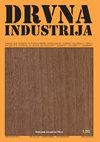Effect of Using Urea Formaldehyde Modified with Extracts in Plywood on Formaldehyde Emission
IF 0.8
4区 农林科学
Q4 MATERIALS SCIENCE, PAPER & WOOD
引用次数: 1
Abstract
Formaldehyde-based adhesives are used in the forestry industry. This is because formaldehyde is inexpensive, easy to use and resistant to moisture; it also has particular mechanical effects. Formaldehyde has both advantages and disadvantages. It is known that various diseases such as lung cancer occur in humans as a result of the release of formaldehyde into the air during and after board production. In this study, a urea formaldehyde glue mixture was prepared by using four different fillers (extract of maritime pine (Pinus pinaster) and elm (Ulmus glabra) bark, extract of hazelnut (Corylus avellana) husk and acorn tannins) at two different ratios. The bonding shear strength of pine (Pinus sylvestris) and spruce (Picea orientalis) plywood produced with urea formaldehyde adhesive was tested according to EN 314-1 standard. All plywood, except the plywood with acorn tannin, met the requirements of the standard. A formaldehyde emission test of the plywood was carried out in accordance with EN 713-3 standard. With this approach, it is possible to quickly determine formaldehyde emissions. Experimental results were obtained for subsequent measurements, including chamber tests. It was observed that the elm bark extract reduced the formaldehyde emission of pine plywood by 40 %, while other fillers reduced it by 3-37 %.脲醛提取物改性胶合板对甲醛释放量的影响
甲醛基胶粘剂用于林业工业。这是因为甲醛价格低廉,使用方便,耐潮湿;它也有特殊的机械效应。甲醛有优点也有缺点。众所周知,在板材生产过程中和生产后,甲醛释放到空气中,导致人类患上肺癌等多种疾病。以海松(Pinus pinaster)和榆树(Ulmus glabra)树皮提取物、榛子(Corylus avellana)壳提取物和橡子单宁(acorn tannins)为填料,以两种不同的比例配制尿素甲醛胶混合物。采用尿素甲醛胶粘剂对松木(Pinus sylvestris)和云杉(Picea orientalis)胶合板进行粘接抗剪强度测试,测试结果符合en314 -1标准。除橡子单宁胶合板外,所有胶合板均符合标准要求。按照en713 -3标准对胶合板进行甲醛释放测试。使用这种方法,可以快速确定甲醛排放量。获得了后续测量的实验结果,包括室试验。榆皮提取物可使松木胶合板的甲醛释放量降低40%,而其他填料可使松木胶合板的甲醛释放量降低3- 37%。
本文章由计算机程序翻译,如有差异,请以英文原文为准。
求助全文
约1分钟内获得全文
求助全文
来源期刊

Drvna Industrija
MATERIALS SCIENCE, PAPER & WOOD-
CiteScore
1.80
自引率
9.10%
发文量
32
审稿时长
>12 weeks
期刊介绍:
"Drvna industrija" ("Wood Industry") journal publishes original scientific and review papers, short notes, professional papers, conference papers, reports, professional information, bibliographical and survey articles and general notes relating to the forestry exploitation, biology, chemistry, physics and technology of wood, pulp and paper and wood components, including production, management and marketing aspects in the woodworking industry.
 求助内容:
求助内容: 应助结果提醒方式:
应助结果提醒方式:


